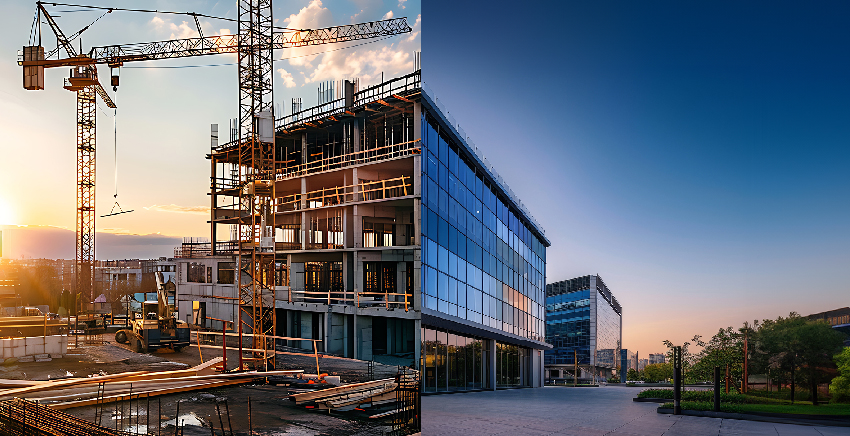Ever thought whether it is better to buy a ready-possession home or one that is under construction? For homebuyers, the decision between an under construction vs ready to move property is critical. The right choice depends on individual needs, financial readiness, and personal preferences, with factors like cost, customization, risk tolerance, and urgency playing major roles. Understanding the advantages and drawbacks of each option will help buyers make an informed decision aligned with their long-term goals.
Ready-to-Move-In Flats
Ready-to-move apartments are fully constructed and available for immediate possession. These homes offer the advantage of moving in right away, without the uncertainty of construction delays. Buyers can inspect the property’s quality, amenities, and neighborhood before making a decision, ensuring peace of mind regarding the final product.
Let’s look at the pros & cons of move-in ready apartments.
Advantages of Ready-to-Move-In Flats
- Immediate Possession and Move-In
- The primary advantage of a ready-to-move-in flat is that it’s available for immediate occupancy. There’s no waiting period, making it ideal for buyers who need a quick settlement, such as those relocating or seeking immediate housing solutions.
- No Waiting Period or Construction Delays
- Ready to move properties come with the certainty of timelines. Since construction is complete, there are no concerns about potential delays that can be associated with under-construction projects. flats, buyers can inspect the unit, quality, and surrounding amenities beforehand. This firsthand experience provides clarity on what they’re investing in, including the construction quality, neighborhood vibe, and communal facilities.
- Lower Risk of Project Abandonment
- Ready-to-move properties significantly reduce the risk of project non-completion, providing peace of mind to buyers. They don’t face the uncertainty that might come with the project’s completion status or legal issues, which are more common in under-construction properties.
Disadvantages of Ready-to-Move-In Flats
- Higher Price Compared to Under-Construction Flats
- Ready-to-move properties generally come at a premium since the project is completed. Buyers pay for the assurance and convenience of moving in right away, which often means a higher upfront cost.
- Limited Options for Customization
- Since the unit is already built, making structural changes or modifying layouts to suit personal preferences is often restricted. Buyers looking for tailored features might find this to be limiting.
- May Not Benefit from Potential Property Value Appreciation During Construction
- Property value for ready-to-move homes is usually stable, meaning buyers miss out on potential price appreciation that often accompanies under-construction projects.
Under-Construction Flats
Under-construction apartments are still being built, offering a lower upfront cost and the potential for customization during the construction phase. Buyers can often take advantage of price appreciation as the project progresses. However, the risks include potential construction delays, uncertain final quality, and the added cost of GST.
Take a quick look about the pros & cons of under construction homes
Advantages of Buying Under-Construction Flats
- Lower Upfront Cost Compared to Ready-to-Move-In Flats
- One key advantage of an under construction property is that they often have lower entry costs than completed properties. Payments are typically staggered over time, easing the initial financial burden.
- Potential for Higher Returns on Investment
- Under-construction properties often appreciate as the project progresses. For investors or homebuyers with long-term perspectives, this can offer substantial returns by the time the property is completed.
- More Options for Customization
- Under-construction properties offer flexibility for personal customization, from interior finishes to layout modifications, allowing buyers to make the space uniquely their own.
- Possible Tax Benefits on Home Loan
- Buyers who purchase under-construction flats may enjoy tax benefits on home loan interest payments and principal repayments. Tax savings can add to the long-term financial advantages.
Disadvantages of Buying Under-Construction Flats
- Difficulty in Assessing Final Quality Before Completion
- With under-construction properties, buyers rely heavily on project promises and renders. There’s often uncertainty regarding the final quality and how the completed project will align with expectations.
- GST Implications May Differ
- Under-construction properties generally attract GST, adding to the overall cost. Ready-to-move properties are exempt from GST, making them potentially more affordable.
Factors to Consider When Choosing
- Budget and Affordability
- If affordability is a priority, under-construction properties may be preferable, offering staggered payments and lower initial costs. Ready-to-move properties, although convenient, come with a higher upfront price.
- Urgency to Move In
- For buyers needing immediate housing, ready-to-move properties are ideal as they don’t involve construction waiting periods. For those with flexible timelines, under-construction properties offer cost savings and potential appreciation.
- Preference for Customization
- Buyers seeking specific layouts or design elements may lean toward under-construction flats. Ready-to-move flats have limited customization options, which may not appeal to those wanting a personalized space.
- Investment Goals
- Whether one is considering real estate investment options or looking for a personal home, it’s important to evaluate long-term plans. Buyers looking for long-term capital appreciation might favor under-construction properties, while those seeking rental income or immediate use would benefit from a ready-to-move option.
- Risk Tolerance
- Ready-to-move properties are lower risk with fewer uncertainties, appealing to cautious buyers. Conversely, under-construction flats, though potentially more rewarding, involve risks such as construction delays or potential quality discrepancies.
Conclusion
Before making a final decision, creating a property purchase checklist can be beneficial for both first-time buyers and experienced investors. Choosing between under-construction and ready-to-move properties requires careful consideration of personal needs, financial situation, and long-term goals. Amanora Park Town offers a range of property options, whether you prefer ready-to-move or under-construction units. For example, Amanora Crown Towers provides properties with potential for appreciation. With a thriving real estate market in property in Hadapsar, buyers have multiple avenues to find their ideal home. Evaluating these factors thoroughly can help buyers make a choice that best fits their lifestyle and financial goals.





